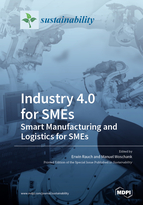Industry 4.0 for SMEs - Smart Manufacturing and Logistics for SMEs
A special issue of Sustainability (ISSN 2071-1050). This special issue belongs to the section "Sustainable Management".
Deadline for manuscript submissions: closed (31 March 2020) | Viewed by 129405
Special Issue Editors
Interests: industry 4.0; industry 4.0 for SMEs; smart manufacturing; manufacturing systems; cyber-physical production systems; sustainable production
Special Issues, Collections and Topics in MDPI journals
Special Issue Information
Dear Colleagues,
In recent years, the industrial environment has been changing radically due to the introduction of concepts and technologies based on the fourth industrial revolution (also known as Industry 4.0). The fourth industrial revolution should extend to the whole production and supply chain and not only, like in the past revolutions, to the mechanical manufacturing process of products and the associated process organization. A production based on the principles of industry 4.0 creates the conditions to replace traditional structures, which are based on centralized decision-making mechanisms and rigid organizational forms. These structures are replaced by flexible reconfigurable manufacturing and logistics systems, decentralized and collaborative decision-making mechanisms, as well as digitally supported processes.
In recent years, SMEs have moved into the focus of many economies. Due to their flexibility, entrepreneurial spirit, and innovation capabilities, SMEs have proved to be more robust than large and multi-national enterprises. Small organizations are increasingly proactive in improving their operational processes, which is a good starting point for introducing the new concepts of Industry 4.0. The successful implementation of an industrial revolution like Industry 4.0 has to take place not only in large enterprises, but shows a high potential especially in SMEs. The readiness of SME-adapted Industry 4.0 concepts and the organizational capability of SMEs to meet this challenge exist only in some areas. This opens the need for further research and action plans for preparing SMEs in a technical and organizational direction. Therefore, special research and investigations are needed for the implementation of Industry 4.0 technologies and concepts in SMEs. SMEs will only achieve Industry 4.0 by following SME-customized implementation strategies and approaches and realizing SME-adapted concepts and technological solutions.
This Special Issue represents a collection of theoretical models as well as practical case studies related to the introduction of Industry 4.0 concepts in small- and medium-sized enterprises.
Submissions to this Special Issue related to, but not limited to, to the following topics are welcome:
- smart manufacturing
- smart logistics
- manufacturing organization
- material flow organization and simulation
- material tracking and identification in smaller industrial companies
- modern and digital supply chain management
- maintenance 4.0
- sustainable production
- social sustainability in industry 4.0
- cyber-physical systems and cyber-physical production systems
- automation and man–machine interaction for SMEs
- internet of things in manufacturing and logistics
- IT in production, logistics, and supply chain management
- new technologies in production and logistics management
- new approaches for computational design and engineering in SMEs
- digital transformation in SMEs
- smart business models for SMEs
- organization and network models for SMEs
- implementation strategies and roadmaps for SMEs
Dr. Erwin Rauch
Dr. Manuel Woschank
Guest Editors
Manuscript Submission Information
Manuscripts should be submitted online at www.mdpi.com by registering and logging in to this website. Once you are registered, click here to go to the submission form. Manuscripts can be submitted until the deadline. All submissions that pass pre-check are peer-reviewed. Accepted papers will be published continuously in the journal (as soon as accepted) and will be listed together on the special issue website. Research articles, review articles as well as short communications are invited. For planned papers, a title and short abstract (about 100 words) can be sent to the Editorial Office for announcement on this website.
Submitted manuscripts should not have been published previously, nor be under consideration for publication elsewhere (except conference proceedings papers). All manuscripts are thoroughly refereed through a single-blind peer-review process. A guide for authors and other relevant information for submission of manuscripts is available on the Instructions for Authors page. Sustainability is an international peer-reviewed open access semimonthly journal published by MDPI.
Please visit the Instructions for Authors page before submitting a manuscript. The Article Processing Charge (APC) for publication in this open access journal is 2400 CHF (Swiss Francs). Submitted papers should be well formatted and use good English. Authors may use MDPI's English editing service prior to publication or during author revisions.
Keywords
- Industry 4.0 for SMEs
- smart manufacturing for SMEs
- smart logistics for SMEs
- digital transformation of SMEs







